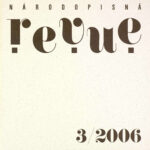The Ethnographic Revue 3/2006 touches clubs, club life and grouping of inhabitants in town and in the country. Yvona Činčová brings nearer the research of that phenomenon in Zlín (Club Life in Zlín in the course of the Bata company expansion). Two contributions by Václav Michalička (The Participation of a Metylovice Strapmaker's Section in the Professional and Village Life) and Karel Altman (The Picture of National Development in Brno within the Activity of Typographers' Clubs) deal with concrete life of strapmakers and typographers. Marta Ulrychová describes the life of the city society in Pilsen (The Promenade of Pilsen). The grouping of folklore fans in Bratislava is the theme by Barbora Skraková (“Folklorists” in Bratislava – a view of the life of an interest group).
The Transforming Tradition column deals with wickerwork as a handicraft (Jarmila Pechová). The social chronicle remembers anniversaries the pedagogue Alena Schauerová (born 1936) and ethnographer Ludmila Tarcalová (born 1946) and publishes the obituary articles devoted to Helena Johnová (1926-2006) and Jindřich Hovorka (1937 – 2006). Into other regular sections, the reports of conferences, festivals and reviews of new books have been involved.
Club Life in Zlín in the course of the Bata company expansion
The study deals with the club life in the town of Zlín thoroughly, especially with its greatest development in the 1920s and 1930s within the context of the development of the local Bata Company. Tomáš Baťa, its founder, and later his brother Jan Antonín Baťa granted the foundation and activity of a lot of clubs, especially those with sports orientation. Their assistance to the associations that ensured the health care of the town’s inhabitants was no less important. Unique was the Baťa Supporting Found that financed the hospital operation as well as the social and cultural needs of the employees. The Bata Company covered not only the social and economical but also the cultural and civil development of the town of Zlín.
The Participation of a Metylovice Strapmaker's Section in the Professional and Village Life
In the past, the village of Metylovice was connected with leather industry inherently. In the second half of the 19th century, the hitherto mainly rural village turned into the artisan and rural one gradually. The reason was the manufacture of quality whips that were distributed into whole Europe. At the beginning of the 20th century, a strapmakers ́ section was formed here. It fell within the mixed guild in Frýdlant until 1932 and then within the professional Guild of Saddlers and Strapmakers in Místek. The section as an economical and social unit influenced the village events significantly. The strapmakers became an organized group with an exceptional position and they were allowed to develop other club activities. They took an essential part in the social transformation of their village.
The Picture of National Development in Brno within the Activity of Typographers' Clubs
The fate of Czech typographers ́ grouping in Brno is a typical example of a process, during which the originally Utraquist association was divided in the second half of the 19th century. Those clubs were founded together by Czech and German members at a time when the national differences between those two groups did not come into prominence. Therefore, both languages, Czech and German, were spoken there. The consequences of gradual increase in national tends on the German side, as well as spreading of national awareness among the Czech inhabitants came to light even in the life of Brno printers. The Utraquist association division resulted in two clubs – the Czech and the German ones – with similar polarization and activities. The Veleslavín Czech Typographic Education Organization was involved among the principal national clubs in Brno, which developed rich social and entertainment activities.
The Promenade of Pilsen
The text about the promenade in Pilsen is based on the study of archives, period press responses, memoirs, imaginative literature and quantitative investigation by means of which the author tried to reconstruct the interwar appearance of the promenade in Pilsen. In Pilsen, the promenade development was similar to other Czech towns. The specificity of Pilsen was caused by the terrain (people promenaded in the square, along new roads and especially in the orchards of the Town Centre) and by the way of life in which mostly the middle classes took part over the period of Austria-Hungary. After the World War I, the secondary-school youth entered the promenade and later on, it gained its prevalence over the middle classes there. The promenade functioned as a “marriage bureau” of young people, controlled by the public, and a place where the young people got familiar with good manners and taste. The Nazi terror following the assassination of the Reichsprotektor Heydrich and the changes within the hierarchy of shared values after the World War II contributed to the extinction of the promenade.
“Folklorists” in Bratislava – a view of the life of an interest group
The contribution deals with a city social group formed pursuant to the group awareness, which has been based on the natural and fostered relation to and interest in traditional culture. The group consists of both the active and former members of folklore ensembles as well as of other fans of folk culture, who take an active part in the social life of those first mentioned. The matter of interest and the rate of understanding regarding the traditional art within the Bratislava environment are especially connected with the rich activity and production of ensembles that use different stages of the traditional art’s conventionalization. Recently, we can follow the opinion and creative orientation of authors, interprets and consumers to tend to understanding and high evaluation of “authentic” expressions (or expressions which are conventionalized minimally). In a large extent, a quiete new phenomenon of personal self-realization – the so-called Dancing-House – has merit in it.



